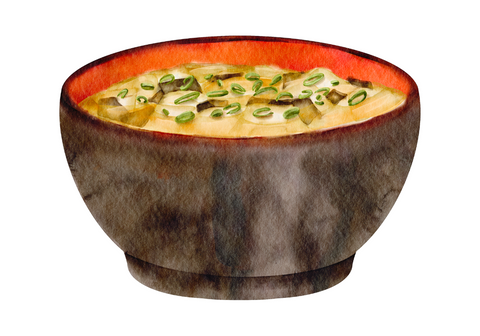
Have you heard of the Japanese proverb ‘味噌汁は不老長寿の薬’ miso shiru wa furou chouju no kusuri’? It translates as ‘Miso soup is medicine for eternal youth and longevity’.
Quite the bold statement! But it encapsulates the importance of miso soup and how it has been treasured for 1800 years in Japanese cuisine.
Tokugawa Ieyasu, who is said to have been Japan’s first ever 健康オタク health nerd, is said to have enjoyed a daily miso soup with 五菜三根 gosai sankon, which means 5 types of vegetables and 3 types of root vegetables. That sounds more like a casserole!
Ieyasu was the first shōgun of the Tokugawa Shogunate that ruled Japan from 1603 until the Meiji Restoration in 1868 and this special miso soup may well have contributed to his long life of 75 years in an era when the average life expectancy was 37 years.
Read on to learn of the benefits of miso and miso soup known today.
Includes ceramide that keep the skin hydrated
Miso is said to contain properties that increases ceramide that is important in maintaining healthy skin. A miso soup a day keeps the skin hydrated, plump, and supple!
Could increases elasticity of the skin
Miso contains 18 types of amino acids including lysine and proline, which are important for collagen production. Collagen is one of the most abundant proteins in the skin, making up 75-80% of the organ, says New York City-based dermatologist Debra Jaliman, MD.
May slow down the signs of ageing
Miso contains antioxidants such as vitamin E, iso-flavones or saponins. Vitamin E and melanoidins is the dark pigment responsible for the colour of aged miso. Antioxidants neutralise damaging free radicals in the body so they are very important in fighting the signs of ageing, as well as boosting overall health.
A powerful probiotic that aids digestion
The double fermentation process makes miso a powerful probiotic food. It can also withstand heat, which means its live probiotic effect will not be lost whilst cooking (heat-killed probiotics are also beneficial for a healthy gut).
The enzymes in koji mould and lactic acid restore beneficial gut bacteria, aiding digestion and assimilation of nutrients. There are even studies that have found people who regularly have miso soup are less likely to get stomach ulcers or gastritis.
And… it’s warm and nourishing❣️
Aside all these benefits, it’s just a wonderfully good soup. No wonder miso soup, miso shiru, in Japanese, has caught on in the UK.
Many our customers like to start their meal with this comforting soup as a starter. While this is absolutely fine and obviously we are very happy to serve food in any order that our customers like to enjoy, we thought it may be interesting to know the typical Japanese way of miso shiru.
Miso soup is an essential component of a Japanese teishoku meal

So Restaurant Weekday set lunch yakitori chicken teishoku
A typical Japanese home cooking meal consists of a main dish, maybe a side or two of vegetables, miso soup, and a bowl of steamed rice. Many eateries also serve set meals in this style, typically known as a ‘teishoku’ 定食, often offering free refills of rice.
At So Restaurant, we offer set lunch teishoku on weekdays. The choice is either the yakitori chicken (above) or salmon rikyu-yaki, which is sashimi grade salmon marinated in miso and grilled with an aromatic coat of white and black sesame seeds.
三角食べ Sankaku tabé, Triangle method
Japanese teishoku is served together, unlike a course meal. And Japanese people tactfully employ the ‘sankaku tabe’ 三角食べ, triangle method △▲▷▼◁◀︎
Let me explain. One takes a bite of the main and one or two helpings of rice, then a mouthful of miso soup… and continue. All decent Japanese people are able to finish each dish in the teishoku around the same time, in a nice balanced way. This is also known as ‘rice management’ 🍚
I am ashamed to admit I struggle with this. I would finish the okazu おかず main and side dishes, and have leftover a bowl of unflavoured rice. So I would need furikake ふりかけ (tasty sprinkles for rice, which I see is also having a moment here in the UK), or pickles 漬物.
Although chef Zu stresses that steamed Japanese rice is a feast in its own right, delicious on its own and that he could devour heaps of it as it is.
So the miso soup is an important member of the sankaku-tabe helping everything to go down smoothly.
I honestly don’t know a soul who dislikes miso shiru. Particular ingredients may not agree with some, but no one has ever shunned the whole of the category, as far as I know. It’s a fundamental and integral part of Japanese cuisine.
Rice and miso soup, the golden pair
There is more than just deliciousness that is accomplished with the rice and miso soup combination.
While rice is said to lack lysine or threonine, two amino acids essential to building a strong body, soy beans that are abundantly used in miso, are rich in these two amino acids. On the other hand, rice provides bountiful Methionine (another essential amino acid that plays a critical role in keeping our metabolism healthy) which soy lacks in.
So there you go, the ultimate pair that completes a healthy diet.
Miso soup is also very convenient as it you can put almost anything in it and it’s great. Tofu, veg, bacon, seaweed, fish flakes, dried mushrooms…
HOT 🔥 debate
What’s your favourite miso shiru ‘gu’?
‘Gu’ means ingredient.
I think my all time favourite is tofu and wakame seaweed. Tofu cut into smallish cubes, heated in dashi stock, then wakame is added and simmered for a bit, lastly the heat is turned off and a dollop of miso is dissolved in the broth. I think this is the ultimate comforting soup and just what I need on a chilly morning or after one too many drinks 🍷
Cubed sweet potato is a close second for me. In fact, any kind of potato is great. It slightly melts in a really good way, making the soup thicker, sweeter, richer, and filling… eddoe potato or white potato are also great.
I asked around to hear about people’s favourite gu 具, ingredient, for miso shiru.
豆腐わかめ、大根、なめこ、玉ねぎ
Tofu wakame, daikon radish, nameko mushroom, onion

tofu and wakame seaweed miso shiru
I think a good place to start is with our head chef, Zu. Typical of Zu, he can’t (or refuses), to pick just one favourite of anything. ‘but they’re all equally amazing…’ he would say 😀
Zu was born and brought up in Tokyo, and both his parents and their parents are from Tokyo. Which makes him a true Tokyoite, ‘Edokko’ 江戸っ子.
He started off saying ‘tofu and wakame seaweed is a staple and always great’, then he quickly remembered more as he warmed to the subject and continued ‘daikon radish cut into matchsticks, and nameko mushrooms are amazing too. Oh I do also love thinly sliced onions’.
Excellent choices! These are all traditional gu enjoyed in Japanese households daily.
シジミ shijimi, Small clams

shijimi miso shiru
My good friend from Bath, who has lived in Japan for years with his Japanese wife and two boys and speaks perfect Japanese, tells me his favourite is ‘the small seashells, shijimi’. Which is another brilliant choice! I’d forgotten about these tiny clams of explosive flavour. They make a wonderful dashi broth that you don’t even need any bonito or kombu seaweed, they provide all the umami needed.
Tony also adds ‘I love watching the pretty patterns the miso makes as it cools’ which I hadn’t really paid attention to before but can picture the serene, ever changing image, almost like a cloudy sky just before erupting to rain.
揚げ茄子 agé nasu, Deep fried aubergine
Aya-chan, my sister in law who was born to Japanese parents and spent most of her life outside of Japan, growing up in Nepal and Tanzania, and since lived in Brussels and Australia, tells me her favourite is deep fried aubergine. Oh how divine! It has to be a true labour of love with all the effort that goes into that extra step involving a separate pan. Aya-chan confesses that she’s mostly enjoyed this gu in the freeze dried instant miso soups, which is one of the best types of instant miso soups around.
牡蠣 kaki, Oyster

kaki, oyster miso shiru
My dear brother, born and brought up in UK, and since lived in Belgium and Australia, blurts out oyster! That definitely sounds amazing but also quite decadent 😀
Oysters are much loved in Japan. Fresh oysters, oven baked, Kaki nabé, oyster hot pot and kaki-furai, fried oysters are some of the favoured oyster dishes. So Restaurant’s Kaki furai カキフライ in crunchy panko, prepared on special occasions are received very well.
ネギ 豆腐 茗荷 | わかめ 茄子 玉ねぎ
Negi, tofu, myouga | wakame, nasu, tamanegi
spring onion, tofu, myoga | wakame, aubergine, onion

myoga
My good friend from Brighton who has a Japanese mother from Tokyo, starts by saying it’s all about the combination. The fantastic cook that she is, she is absolutely right. Most homemade miso soups have at least two gu.
The first she mentioned was spring onion, tofu, and myoga. Mouga, also known as Japanese radish is another that had fallen to the back of my mind and I was glad to be reminded of. It makes a delicious crunchy miso soup gu.

hiyayakko chilled tofu with myouga
Myoga is also wonderful finely cut and placed on top of hiyayakko chilled tofu as a summery side dish.
I hope this has inspired you to try more miso soup!
If you’re looking to make your own, head to our sister company, Sozai cooking school for Japanese cooking tips. https://www.sozai.co.uk/
I’d like to finish off with some more Japanese miso proverbs that I stumbled upon.
焚火(たきぎ)一丁、みそ雑炊三里
takigi iccho, miso zosui sanri
A fire pit is only warm for 110 metres. A bowl of miso zosui (miso with rice) will keep you warm enough to walk 4km
医者に金を払うよりも、みそ屋に払え
Isha ni kane wo harauyorimo, miso-ya ni harae
Instead of paying your doctor, pay the miso shop.
ie Invest in miso for your daily diet and keep healthy, rather than getting ill and paying the doctor.


